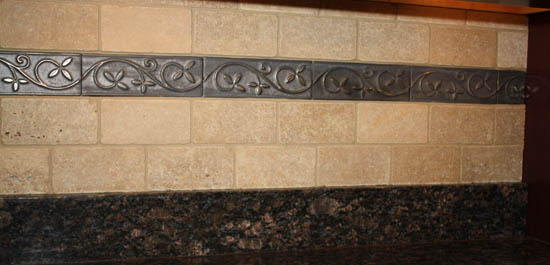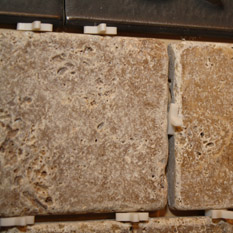How To Grout Kitchen Backsplash Tiles


Grouting Kitchen Backsplash Tiles
As we continue to document the Kitchen Backsplash project that we’re doing this month we wanted to spend this article showing you how to grout the joints between the tiles on a backsplash. If you’re just finding this article now you can read our previous articles on how to tile a kitchen backsplash at the following links:
- Choosing Kitchen Backsplash Materials
- Designing A Kitchen Backsplash
- Thinset vs Mastic for Kitchen Backsplash
- How To Install Kitchen Backsplash Tiles


Before getting into the details of how we grouted the tile joints I wanted to point out a couple of features with our decorative accent tiles. We chose a decorative tile that runs around the entire kitchen in the third row of tiles. The tile actually looks like a metal tile with a repeating pattern of vines or flowers. The pattern is such that we decided to use zero space between them and no grout in the vertical joint between decorative tiles. The tiles are colored around the edges so that you can install them in this fashion without grout.
In order to keep grout out of those joints we taped off all the decorative tiles with painters tape. The painters tape is easy to install and ensures that none of the grout works its way into the joints.
Selecting Backsplash Grout
Before grouting your new backsplash you’ll need to select a grout. There are several things to consider when selecting grout including:
- Color – Most designs try to pair a complimentary color that takes a back seat to the tile. In other words choose a color that will blend in and not draw attention. For the project we selected a color called “camel” which blends nicely with the tan color of the marble tiles.
- Sanded vs Unsanded Grout – There are two basic types of grout to choose from depending on the width of your grout joints. If your grout joints are 1/16 inch then unsanded grout is best. For joints larger than 1/16 inch a sanded grout is best as it’s less likely to crack. For this project we’re using a sanded grout.


How To Grout Tile Joints
Traditionally tile grout is installed using a rubber trowel to press the grout into the joints. This method works very well on floors, large walls and smooth glass or subways tiles on backsplashes. However, for our project we are faced a couple of issues that make the traditional method hard to do.
- We used a tumbled marble tile, 4 inches by 6 inches, with lots of holes, voids and rough surfaces. We didn’t want those voids to be filled with grout but rather to maintain the voids for character.
- We already had a six inch tall granite backsplash in place which reduced the total height of tile to 14 inches. Having only 14 inches of space made using a large sponge and rubber trowel (pictured above) very difficult.
Because of these two issues I decided to use a method that I’ve only read about and that’s to use a pastry bag to “squirt” the grout into the joints. By using the pastry bag I was able to keep the grout focused to just the width of the joint and minimize how much grout was applied to the surface of the tiles.
The following is a short video showing how quickly I was able to grout the tile joints using a pastry bag. I used a standard pastry bag with a round #10 tip. The premixed grout is almost the same consistency as frosting so it worked beautifully.
After successfully grouting the joints I needed to trowel or “work” the joints. This accomplishes two things, first of all it allowed me to remove any excess grout and secondly it also ensures that the joints are full and there are no voids. I used a small putty knife to work each of the grout joints. It’s important to only work with a small area at once. You’ll want to grout the joint, work the joint and then clean the tiles before moving on. The following short video shows you how I troweled the joints.
It’s also really important that you not work the grout joints to vigorously as you’ll pull out all the grout and also weaken the final grout lines. Again one of the keys to this is only tackling and area that’s large enough that you can successfully grout, trowel and clean off before the grout cures and hardens to the surface of the tiles.
Final Thoughts On Grouting Backsplash Tiles
Grouting tiles isn’t that difficult if you’re prepared and take your time. The key to a successful job is doing small areas so you have plenty of time and don’t get ahead of yourself. Also, smooth tiles with small joints are the easiest to grout while porous tiles with large joints are more work. Using a premixed grout with sealers already in it will save you time and aggravation. If you don’t use a premixed grout be sure to seal your grout after it’s cured with an approved grout sealer to protect against staining and mold.
If you’d like to see the final pictures of our new backsplash along with a summary of all the backsplash articles then visit our complete guide on how to install a kitchen backsplash.
Recent Posts
Framing Stick Nailer vs Coil Nailer
Which is Better a Stick Nailer or Coil Nailer? Framers have many choices in nailers…
How Many Roofing Nails Per Square of Shingles
Estimating How Many Nails for a New Roof When it comes to estimating materials for…
Composite / PVC Decking – Layout Tips & Advice
Composite / PVC Decking Layout Tips and Advice Composite and PVC decking have really changed…
Benefits of an ERV System (Energy Recovery Ventilator)
Benefits of ERV Systems (Energy Recovery Ventilator) If you're building a new home or doing…
Vermiculite Attic Insulation Abatement
Vermiculite Attic Insulation If your home was built before 1990 there is a chance it…
Nuisance Tripping of AFCI (Arc Fault) Circuit Breakers
Arc Fault (AFCI) Circuit Breakers Tripping Often An arc-fault circuit interrupter (AFCI) or arc-fault detection…
View Comments
Todd, I think the way you are integrating videos into your articles is really helpful! This is a very good series that we'll be following when we tile our own backsplash this fall.
Fred - Thanks...glad you liked it!
Todd,
I agree. A real nice series and Kudos with the videos. ROB
Thanks for taking the time to create these videos instead of just writing a tutorial, it makes it so much easier seeing it being done rather than just reading a "How to" guide.
Good job !!!...This is very well presented and is a great explanation of common questions such as Mastic versus thinset
I too am doing a tumbled marble backsplash (looks very similar to yours) and using the Tec Inivision premixed grout. Your videos are helpful. Thank you. So the grout has a sealer in it which makes it unnecessary to go back and seal the grout, but is it necessary to seal the stone itself? Our backsplash covers the area behind the sink and the area behind the stove, so it is likely to be exposed to water and food spatters. Is it recommended to treat the stone in any way and if so, would that be done before or after grouting? Thanks again.
If you're tiles will be in an area around the stove then I recommend you seal it. There are several schools of thought on when to seal. Some like to seal before grout as it makes grout clean-up easier. Any some like to seal after and hit the grout again. Frankly I don't think it matters much. What matters is getting a sealer that's right for your tile. Ask you tile supplier for a recommendation. Good luck.
Great series of how-to articles! Thank you for including videos, as well. Very helpful! Question: How would you finish off a subway tile meeting up with a soapstone countertop? Grout alone? Silicone caulk on top of the grout? Thank you so much.
Brenda - Glad you found the articles useful. When the backsplash meets the countertop you definitely need a silicone caulking. I'd butt the tiles tight to the countertop (maybe 1/16" gap), then tape (both counter and tiles), then caulk with a good quality silicone caulking. The tape is hugely important so you don't get caulking on the other finish materials.
Good luck.
Awesome idea! Thanks SO much for giving a detailed video on the process. Am having my backsplash tiled this coming week(also in a 14-inch clearance space), and will DEFINITELY recommend my contractor to use THIS METHOD. Seems to be a MUCH cleaner and precise way of doing it in tighter areas than the usual methods. My contractor Pete may not 'like' my telling him how to do his job, but hey, it's my kitchen and my money, right? Again, thanks for taking the time to provide these great how-to's!
Glad you liked it. I'd mention it to him but let him do it his way. Most reputable contractors are good at what they do. The only thing that matters is having it look great and having no damage to your home.
Good luck.
This is great! I agree that the videos help tremedously! One thing that I haven't determined yet...how do I move the electrical outlets forward to align with the tile? It seems to me that I have seen mention of something that is created for this but not sure what it is.
Thanks so much for your help!
Barb - You may have to buy longer screws (available at most hardware stores in the electrical section) and also some plastic extension washers.
Thanks, I'm just now getting ready to start my project. Have to make a run to the hardware store, so I'll ask about the plastic extension washers.
I kind of wish we would have watched and read this first. My husband has done ceramic floors before and I don’t think he reslized the backsplash would be so different we used a 1/4 in space which looks good with the 3 in x 6 in subway style tile but unfortunately thought we needed I sanded grout bought the dry now getting it off is next to impossible as we didn’t work in smaller places and some has dried completely we also have already had some pieces come out and many grooves has not been sealed any suggestions
The videos don't seem to be available to show the grout/pastry bag method. I really wanted to see that.